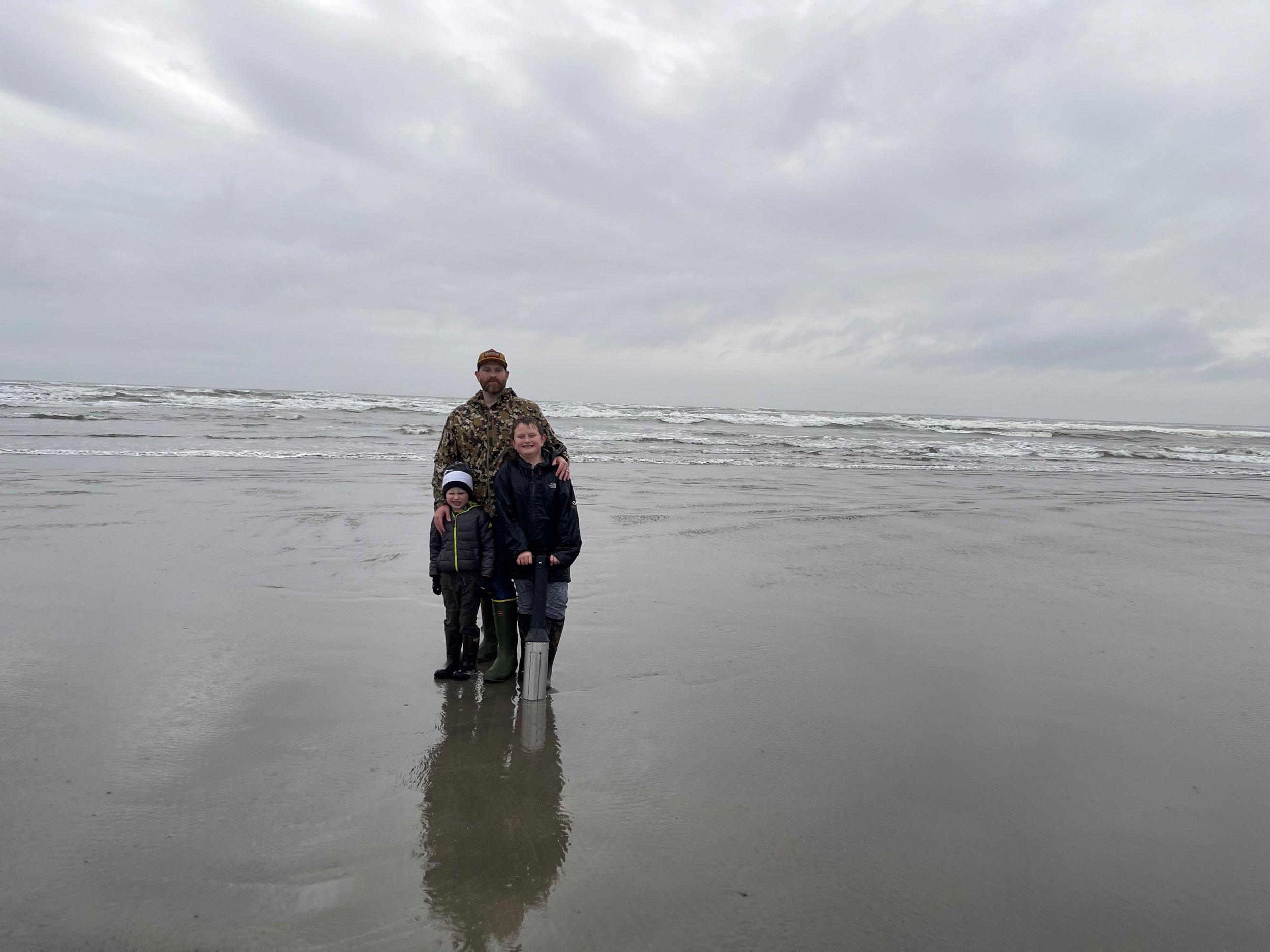All That For Soup
As dusk approached, my Jeep trundled across the dunes, slowly traversing the ever-changing roadway, as fleeting as the grains of sand that it was comprised of. The landscape before us looked like an afterthought, a poorly made line-drawing where the foreground was finished first in great detail, and the background was rushed with overlapping lines. I parked near the clam bed we had discovered during an earlier foray; it had quickly become “our spot.” My green rubber boots sunk slightly as I opened the doors of the Jeep, releasing my two boys from their vehicular imprisonment and into the chill of the night air - their laughter quickly dissipated as the briny Pacific wind consumed all other sounds.
Our quarry was the Pacific razor clam (Siliqua patula), a relatively large bivalve mollusk that has a considerable size variance depending on its latitude - measuring between 3 and 11 inches (increasing in size the further North one ventures) and is covered in a protective shell that calls to mind Winnie-the-Pooh’s shirt – barely containing the creature’s girth. It’s habitat spans from Pismo Beach, California, North to Alaska’s Aleutian Islands, further demonstrating a masterful adaptability across changing weather patterns and locales. Though they only have one foot and no central nervous system, these clams are perfectly built for survival along the rough Washington coast, where we pursue them year after year. They prefer to spend most of their lives submerged within the intertidal zone, which is fortunately well within reach of a clam gun.
We gathered around the rear hatch of the Jeep, the soft glow from the interior lights simulating warmth but releasing none. Our rubber boots, jackets, gloves, and hats were all in position, preventing the opportunistic ingress of the wind. We grabbed our sand-encrusted clam guns and pulled them clear of the rig. The guns were comprised of a stainless-steel cylinder, two feet long and five inches in diameter with a “T” shaped handle that ran perpendicular across the top (sealing the upper section of the tube). Within the handle was a small hole that, when covered, created suction – allowing the digger to pull the clams and their gritty abode free from the beach’s tenuous grasp.
We marched toward the ocean, surveying the beach for the small donut-shaped divots that allude to the clams below. We all wanted the honor of claiming “first clam!” My oldest son paired up with me as an effective spotter and grabber, while my youngest son accompanied my wife a few yards to the South.
Kingston’s young eyes served him well as he pointed out a large hole, “There’s one!” he yelled with all the excitement of Captain Ahab spotting his white whale. I quickly positioned my clam gun over the hole, with a slight favor toward the ocean due to the clam’s propensity to retreat toward the ocean. I sunk the gun in deep, salt water spurted out of the top as I rocked it back and forth until it was buried near the hilt. I’ve got you now, I thought to myself. I could hear its shell glance at the edge of the cylindrical tube. I plugged the hole in the uppermost section of the clam gun, creating a hernia-inducing amount of suction. I strained upward, pulling a sizable amount of sand from the beach. As I released the suction, a two-foot-long core of sand oozed out of the gun. Kingston quickly got to work on his hands and knees trying to locate the clam. “I’ve got him!” He yelled as he hoisted the mollusk over his head. We had first clam.
Like the heavens above, I thought of razor clam digging as somewhat nebulous: it’s not quite hunting, but the action prevents its consideration as a harvest. To describe it as “foraging” also doesn’t properly encapsulate it… but perhaps that’s part of what makes it special, by its very nature it bucks traditional labels and settles within the undefinable.
I looked over my shoulder toward the setting sun and noticed a slight concave – larger than the small circular holes we were acquainted with. “Hey Kingston, I bet that’s a crab,” I said, my voice barely audible over the ever-intruding wind. He quickly began to dig – pulling out an annoyed Dungeness crab from his shallow burrow. His claws fruitlessly grasped at the air, lashing out at anything that could have brought this injustice upon him. After studying him for a few moments we placed him back into his dugout. He settled in and comfortably started blowing bubbles. Everything was right in his world.
As the evening progressed, we continued to fill our mesh bags with the subterranean bivalves. Eventually, we filled our limit as the sun nestled down well below the horizon. Other beachgoers were departing; their trucks butchering the ether with their headlights. Soon we joined them, our headlamps ablaze as we trudged back to the Jeep with our clam guns resting upon our shoulders, like soldiers returning from a distant campaign, our spoils of war bounced with every step: future ingredients for the stockpot.
As the seasons gradually change – a subtle color gradient turning from green to yellow, orange, and red; I know how eventual winter is, like a great devouring beast, it will lay upon us. It’s subtle blanket envelopes our minds, sinking us deeply into the well of submerged ancestral memories when both animals and humans would nestle down and wait out the darkest season. However, our reality is very different than those who preceded us - it doesn’t need to be that way; there is a multitude of outdoor adventures that allow us to enjoy the naked beauty of the winter. As the world spins and the shadows intrude upon the face of our globe, we can bundle up, face the cold, and make some soup… at least that’s my plan with all of these clams.



